How to Start a Blog That’ll Actually Make Money
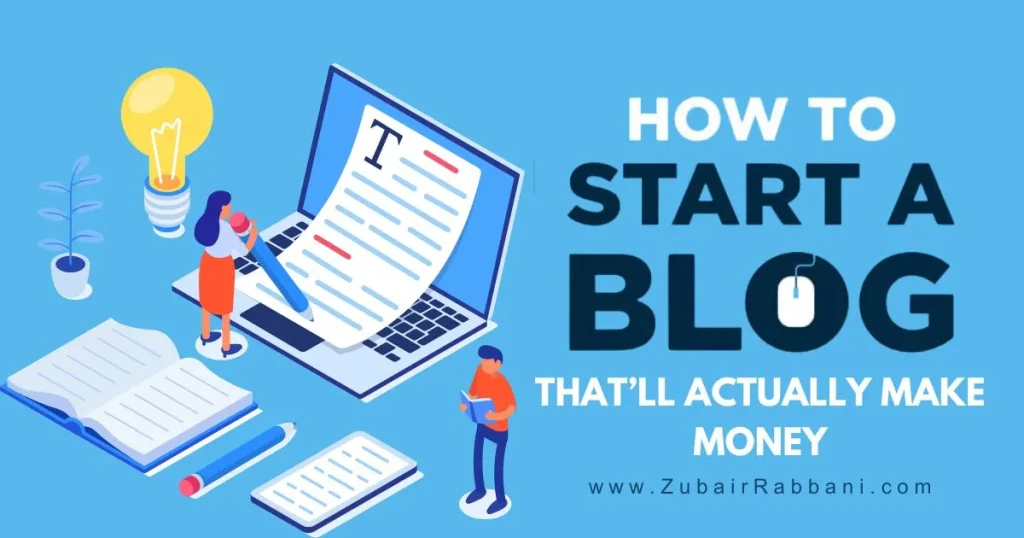
Welcome to the exciting world of blogging, where creativity meets opportunity, and your words have the power to resonate across the digital landscape. In the ever-expanding digital landscape, the prospect of starting a blog has become an enticing endeavor for individuals seeking to share their passion, expertise, or creativity with the world.
While the idea of expressing oneself online is appealing, many aspiring bloggers are also drawn to the possibility of turning their digital platform into a source of income. The notion of making money through blogging is not just a dream; it’s a tangible reality for those who approach the process strategically.
How to Start a Blog That’ll Actually Make Money is a guide crafted to navigate you through the exciting yet challenging journey of establishing a blog that goes beyond being a mere online journal. Whether you’re an aspiring entrepreneur, a niche enthusiast, or someone with a unique perspective, this guide will provide you with actionable insights, tips, and a roadmap to not only launch a blog but also transform it into a lucrative venture.
What Is A Blog?
Welcome, curious minds! Today, let’s embark on a journey to unravel the fascinating world of blogs. So, what is a blog, you ask?
In its essence, a blog is an online platform where individuals, known as bloggers, share their thoughts, ideas, experiences, and expertise in a dynamic and frequently updated format. Imagine it as a digital journal that’s not just tucked away under someone’s mattress, but open for the world to explore.
Blogs come in various shapes and sizes, catering to a myriad of interests and niches. From the latest tech trends to culinary adventures, travel escapades, and personal development musings, there’s a blog for every passion under the digital sun.
But it’s not just about pouring words onto a virtual page; it’s a conversation. Blogs invite interaction, creating a community where readers can engage through comments, sharing their perspectives and building connections with like-minded individuals.
The beauty of a blog lies in its versatility. Whether you’re a budding writer, a seasoned expert, or just someone with a story to tell, blogging provides a democratic space where your voice can resonate across the internet landscape.
How to Start a Blog and Make Money in 7 Steps
Hello, aspiring creators and future digital mavens! Today, we’re about to embark on an exciting journey that holds the promise of turning your passion into profit. Ever wondered how to start a blog and make money doing what you love? Well, you’re in the right place.
In the next few moments, we’ll unravel the secrets behind the alchemy of blogging and monetization. It’s not just about sharing your thoughts; it’s about creating a digital haven that not only resonates with an audience but also opens doors to potential income streams.
Buckle up as we guide you through seven strategic steps, each a building block in the foundation of your blogging empire. From choosing your niche to mastering the art of content creation, and finally, unlocking the doors to monetization, we’ve got your roadmap to success right here.
1. Pick a Niche
Selecting a niche is like choosing the palette for your artistic masterpiece—it defines the colors of your content canvas. A niche in the blogging realm is essentially a specialized focus or topic that resonates with a particular audience. It’s the heartbeat of your blog, setting the tone for the conversations you’ll engage in.
When it comes to picking a niche, think of it as finding your blogging sweet spot. What are you genuinely passionate about? What knowledge or expertise do you bring to the table? Your niche is not just a subject; it’s a reflection of your authentic self.
Consider the niches as diverse as a bustling marketplace—fashion, technology, wellness, travel, finance, or even the intersection of multiple interests. The key is to find that sweet spot where your passion aligns with what your target audience is hungry to devour.
2. Choose a Blogging Platform
Now that you’ve sculpted the vision for your blog, it’s time to build its digital home—a process that begins with choosing the right blogging platform. Think of this decision as selecting the architectural blueprint for your online abode.
There’s an array of platforms out there, each with its own set of features, quirks, and user-friendly interfaces. WordPress, Blogger, Medium, and Wix are just a few of the many options. The key is finding the one that aligns seamlessly with your goals and technical comfort.
If you’re looking for flexibility, customization, and a vast community, WordPress might be your digital canvas. It’s akin to a virtual playground where you can tweak and tailor your blog to match your creative vision.
On the other hand, if simplicity is your game, platforms like Medium offer a streamlined experience, letting you focus on your content without getting bogged down by the technical intricacies of website management.
Consider your long-term aspirations too. Some platforms may be more scalable and adaptable as your blog grows, while others might be perfect for a straightforward, minimalist approach.
Ease of use is paramount. A user-friendly interface ensures that your energy is spent crafting content rather than wrestling with the technicalities of your chosen platform.
Also Read This: How to Turn 10K to 100K
3. Choose a Domain Name and Hosting
Now that you’ve laid the groundwork with a chosen niche and a blogging platform, it’s time to give your digital space a distinct identity. This is where the importance of choosing a domain name and hosting comes into play—it’s like picking the street address for your online residence.
Your domain name is your blog’s unique address on the internet, the name that visitors will type into their browsers to find you. It’s not just a web address; it’s your blog’s brand, the first impression that lingers in the minds of your audience. Keep it simple, memorable, and reflective of your blog’s essence.
Once you’ve brainstormed and secured the perfect domain name, it’s time to find a hosting provider. Hosting is like renting space on the internet where your blog’s files, images, and content will reside. Consider it as the foundation of your online home.
There are various hosting providers out there, each offering different plans and features. Consider factors like reliability, customer support, and scalability. You want a hosting provider that can accommodate your blog’s growth and ensure a seamless experience for your visitors.
Remember, the right domain name and hosting are not just technical details; they’re crucial elements of your blog’s brand and accessibility. They contribute to the overall user experience and play a role in how your blog is perceived by both visitors and search engines.
The web host we recommend is DreamHost, mainly because:
- You get a free domain name when you register
- Free Secure Socket Layer (SSL) certificate
- Free automated WordPress migration
- They also offer a free WordPress website builder
- 100% uptime guarantee, so you don’t have to worry when your site goes down.
- 97-day money-back guarantee in case you’re unsatisfied for any reason.
How to Create Your DreamHost Account
Ah, DreamHost—a digital haven where dreams of hosting your own website come true! If you’re ready to take the plunge into the world of web hosting, creating your DreamHost account is the first exhilarating step. Let’s walk through the process in four simple and seamless steps.
Step (i): Navigate to DreamHost
Begin your journey by pointing your browser to the DreamHost website. The anticipation builds as you prepare to transform your digital dreams into reality. Once there, click on the “Sign Up” or “Get Started” button, signaling the commencement of your hosting adventure.
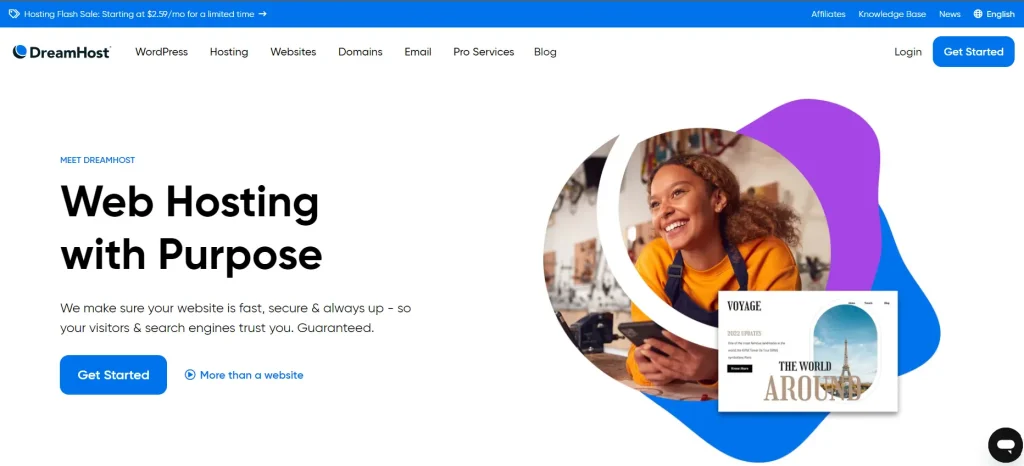
Step (ii): Choose Your Plan
DreamHost offers a variety of hosting plans, each catering to different needs. Whether you’re envisioning a personal blog or a bustling e-commerce site, pick the plan that aligns with your aspirations. Take a moment to explore the features, ensuring your chosen plan is a perfect match for your web hosting dreams.
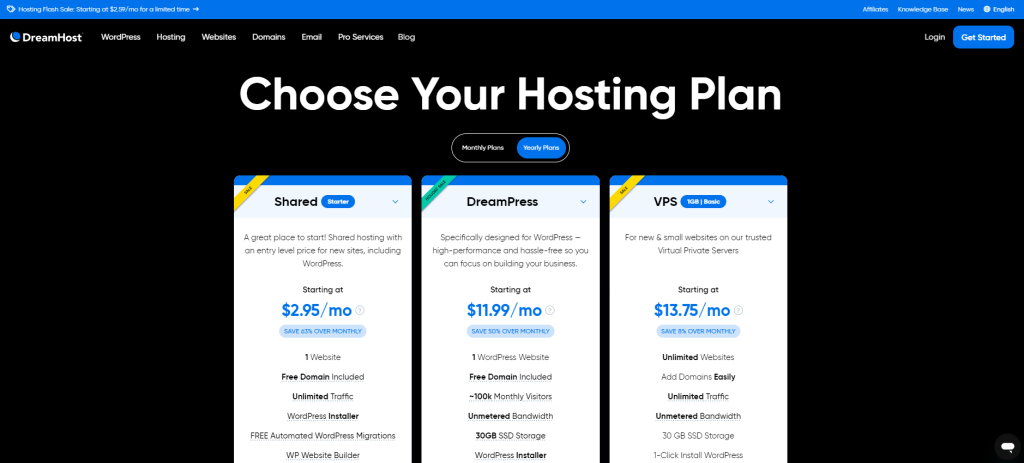
Step (iii): Select Your Domain Name
Your domain name is the beacon that guides visitors to your online sanctuary. During the signup process, you’ll have the chance to either register a new domain or transfer an existing one. Choose a name that reflects your identity and resonates with your audience. Remember, this is your blog’s virtual address—make it memorable!
Step (iv): Complete the Registration Process
With your plan and domain selected, it’s time to wrap up the registration process. Fill in the necessary details, review your choices, and voila! You’re on the cusp of launching your website into the digital cosmos. Confirm your choices, make any additional customizations, and revel in the excitement of your soon-to-be digital home.
And there you have it—a swift and straightforward guide to creating your DreamHost account. Your journey into the realms of web hosting is now officially underway. Brace yourself for the thrilling chapters ahead as you bring your digital dreams to life. Happy hosting!
Also Read Thsi: Online Money Earning Websites- $100 A Day
4. Design Your Blog and Customize
Welcome to the creative playground of the digital realm, where the aesthetic magic happens—designing and customizing your blog! As you embark on this phase of your blogging journey, envision your blog as a canvas waiting for the brushstrokes of your unique style and personality.
Designing your blog is more than just choosing colors and fonts; it’s about crafting an immersive experience that resonates with your audience. In this exploration, we’ll unravel the art of customization, delving into the intricacies of layout, visuals, and the overall vibe you want your digital space to exude.
Think of it as curating your own virtual gallery, where each element tells a story and invites your readers to immerse themselves in your narrative. From the layout that guides their journey to the visuals that capture their attention, every design choice contributes to the ambiance of your online sanctuary.
Whether you’re a minimalist aficionado or a maximalist enthusiast, there’s a design language that speaks to you. Through this journey, you’ll discover how to make your blog not just a platform for content but a visual representation of your brand and identity.
So, buckle up and get ready to explore the world of themes, widgets, and customization options. Your blog is about to undergo a transformation, and with a sprinkle of creativity, it will reflect the essence of you. Design away, and let the visual storytelling begin!
Log in to Your WordPress Blog
Entering the backstage of your digital realm is as simple as a few keystrokes—welcome to the world of WordPress Login! Once you’ve set up your WordPress site, accessing the dashboard is the gateway to a realm where creativity and content converge. Let’s navigate the login process in a few easy steps.
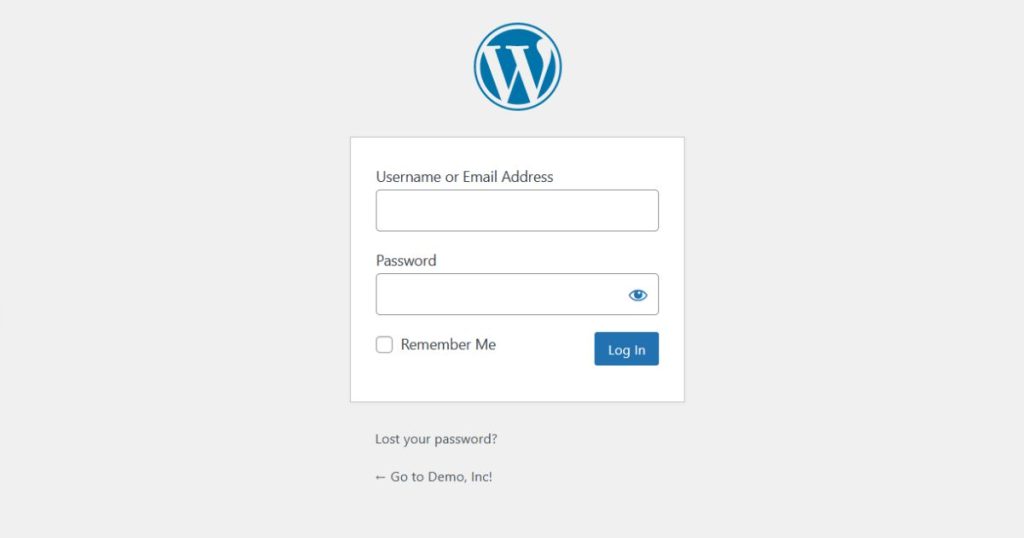
How to Change Your Blog Design
The allure of a fresh look for your blog is undeniable, and luckily, WordPress makes the process of changing your blog’s design as seamless as a wardrobe change. So, if you’re ready to give your digital space a makeover, here’s a step-by-step guide on how to change your blog design in WordPress.
Step 1: Access the WordPress Dashboard
Login to your WordPress dashboard—the command center of your website. If you’re not sure how to do this, refer back to the “How to Login in WordPress” section for a quick refresher.
Step 2: Navigate to ‘Appearance’
On the left sidebar of your dashboard, find and click on ‘Appearance.’ A dropdown menu will appear, offering various customization options.
Step 3: Choose ‘Themes’
Within the ‘Appearance’ menu, click on ‘Themes.’ Here, you’ll find a collection of themes that determine the overall look and feel of your blog. Explore the available options, and when you find one that resonates with your vision, hover over it and click ‘Activate.’ Your blog is now sporting a new design!
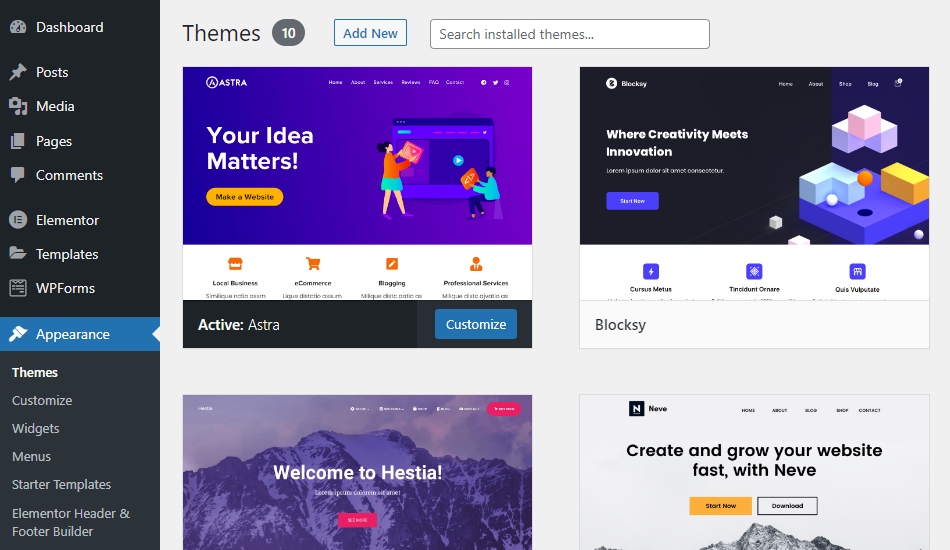
Step 4: Customize Your Theme (Optional)
Many themes come with customization options, allowing you to tweak colors, fonts, and layouts to match your preferences. To do this, click on ‘Customize’ under the ‘Appearance’ menu. Here, you can experiment with different settings until your blog design aligns perfectly with your vision.
Step 5: Explore Theme Options
Some themes might have additional settings or options that can be accessed from the ‘Theme Options’ or ‘Theme Settings’ menu. Take some time to explore these options and tailor the theme to your liking.
Step 6: Install a New Theme (Optional)
If you want to explore beyond the pre-installed themes, you can click on ‘Add New’ in the ‘Themes’ section. Here, you can browse and install new themes from the WordPress Theme Directory or upload a theme you’ve purchased.
And there you have it—a simplified guide to changing your blog design in WordPress. With a few clicks, your blog can undergo a visual transformation, reflecting your evolving style and creativity. So, go ahead, experiment, and let your blog’s aesthetic evolution begin!
5. Write and Publish Great Content
Greetings, wordsmiths and digital scribes! If you’ve ever felt the irresistible urge to share your thoughts, stories, or expertise with the world, you’re in for an exhilarating journey. In this chapter of your blogging saga, we dive into the art of crafting compelling content—welcome to the realm of writing a blog and publishing posts.
Writing a blog is more than just arranging words on a digital canvas; it’s a dance of ideas, a symphony of expression, and a conversation with the world. As you embark on this literary adventure, envision your keyboard as the brush, and each keystroke as a stroke on the canvas of the internet.
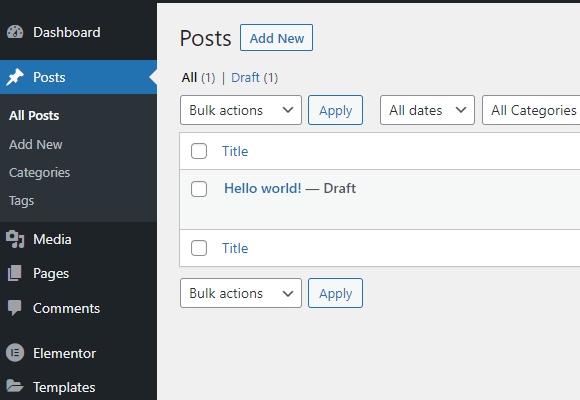
In this exploration, we’ll unravel the secrets of engaging storytelling, effective communication, and the nuances of crafting posts that resonate with your audience. From captivating introductions to thought-provoking conclusions, each element plays a role in creating a narrative that captivates, informs, or entertains.
But it doesn’t end with the writing; oh no, the magic happens when you hit that ‘Publish’ button. Your words, thoughts, and stories are unleashed into the digital universe, ready to be discovered by readers across the globe.
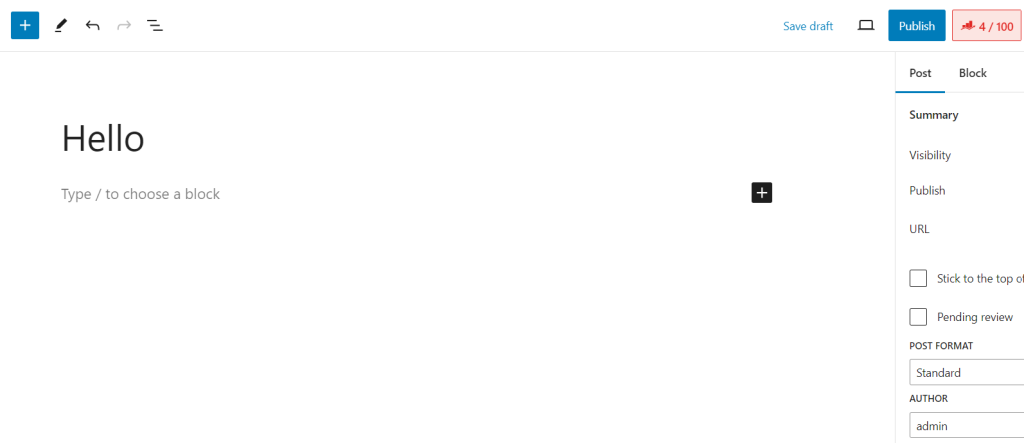
So, whether you’re a seasoned wordsmith or a budding bard, join us in the enchanting journey of writing a blog and publishing posts. Let the words flow, the ideas bloom, and may your digital quill lead you to a realm where your voice is heard and your stories resonate. Happy writing!
Helpful Tips for Writing Great Content
Absolutely! Crafting great content is a delicate art, a fusion of creativity, clarity, and connection. Whether you’re a seasoned writer or just dipping your pen into the digital ink, these tips are here to elevate your content creation game.
1. Know Your Audience: Understanding your audience is the cornerstone of great content. Tailor your writing style, tone, and content to resonate with the people you want to reach. What questions are they asking? What keeps them up at night? Speak directly to their needs and interests.
2. Start with a Captivating Hook: The opening lines of your content are like a firm handshake—they set the tone for the entire interaction. Grab your reader’s attention with a compelling hook, whether it’s a thought-provoking question, a surprising fact, or a relatable anecdote.
3. Be Clear and Concise: Clarity is your ally. Avoid unnecessary jargon or convoluted sentences. Get straight to the point, and let your message shine through without unnecessary clutter. Remember, simplicity is often the key to profound communication.
4. Tell a Story: Humans are wired to love stories. Weave a narrative into your content—it could be a personal experience, a case study, or even a hypothetical scenario. Stories create an emotional connection, making your content more memorable.
5. Provide Value: Your content should be a gift to your readers. Whether it’s information, entertainment, or inspiration, ensure that each piece adds value to their lives. Solve a problem, answer a question, or offer a fresh perspective.
6. Use Visuals Strategically: Images, infographics, and other visuals can enhance your content’s appeal and comprehension. Break up long blocks of text with visuals, making your content more engaging and digestible.
7. Edit Ruthlessly: Writing is rewriting. After you’ve poured your thoughts onto the page, go back and edit with a discerning eye. Trim unnecessary words, refine your sentences, and ensure your message is as clear as possible.
8. Foster Engagement: Encourage interaction with your content. Pose questions, invite comments, and create a sense of community. A blog is not just a monologue—it’s a conversation.
9. Be Authentic: Your unique voice is your superpower. Embrace your authenticity, and let your personality shine through. Readers connect with genuine voices, so don’t be afraid to inject your perspective into your content.
10. Stay Consistent: Consistency builds trust and loyalty. Whether it’s the tone of your writing, the frequency of your posts, or the style of your visuals, strive for a cohesive and reliable presence.
Remember, great content is a journey, not a destination. Embrace the process, refine your skills, and let each piece of content be a step forward in your evolution as a creator. Happy writing!
6. Promote Your Blog
Absolutely! Promoting your blog effectively can significantly increase its reach and impact. Here are four essential steps to help you promote your blog:
- Optimize for Search Engines (SEO): Start by ensuring your blog is search engine friendly. Research and use relevant keywords in your blog posts, titles, and meta descriptions. This will improve your blog’s visibility on search engines, making it easier for people to find your content. Additionally, focus on creating high-quality, valuable content that addresses the needs and interests of your target audience.
- Social Media Promotion: Leverage the power of social media platforms to promote your blog. Share your posts across various channels such as Facebook, Twitter, Instagram, LinkedIn, and Pinterest. Craft engaging and shareable posts with captivating visuals. Engage with your audience, participate in relevant communities, and utilize hashtags to increase the discoverability of your content.
- Email Marketing: Build and maintain an email subscriber list. Encourage visitors to subscribe to your blog for regular updates. Send out newsletters featuring your latest blog posts, exclusive content, and promotions. Personalize your emails to establish a connection with your audience. A well-executed email marketing strategy can help drive consistent traffic to your blog and keep your audience engaged.
- Collaborate and Network: Partner with other bloggers, influencers, or businesses in your niche. Collaborate on guest posts, co-host events, or participate in joint projects. This cross-promotion exposes your blog to a broader audience and builds credibility within your community. Networking also opens up opportunities for backlinks, which can positively impact your blog’s search engine ranking.
Remember, consistency is key in the world of blogging. Consistently produce high-quality content, stay engaged with your audience, and adapt your promotion strategies based on analytics and feedback.
7. Monetize Your Blog
Monetizing your blog is an exciting step that can turn your passion into a source of income. Here are four effective ways to monetize your blog:
- Ad Revenue: Incorporate display ads on your blog to earn revenue based on impressions or clicks. Google AdSense is a popular choice for beginners, as it’s easy to set up. As your blog grows, consider reaching out to advertisers directly for more lucrative partnerships. Ensure that the ads align with your content and don’t overwhelm the user experience.
- Affiliate Marketing: Join affiliate programs related to your blog’s niche and integrate affiliate links into your content. When your audience makes a purchase through these links, you earn a commission. Be transparent about your affiliate relationships to build trust with your readers. Choose products or services you genuinely recommend to maintain credibility.
- Sponsored Content: Collaborate with brands for sponsored posts or reviews. Brands may pay you to create content that features their products or services. Ensure that the sponsored content fits seamlessly into your blog’s theme and provides value to your audience. Clearly disclose any sponsored relationships to maintain transparency.
- Sell Products or Services: Leverage your expertise by selling your own products or services. This could include e-books, online courses, merchandise, consulting services, or any other offerings aligned with your blog’s niche. Create a seamless purchasing experience on your blog, and use compelling content to showcase the value of what you’re offering.
Remember, successful blog monetization often involves a combination of these strategies. Focus on building a loyal and engaged audience first, as they are more likely to support your monetization efforts. Additionally, be patient and adapt your approach based on the evolving needs and preferences of your audience.
Conclusion
Embarking on the journey of creating a blog is not just about sharing your thoughts with the world; it’s about crafting a meaningful and sustainable online presence.
As we conclude this guide on “How to Start a Blog That’ll Actually Make Money,” it’s essential to recognize that success in the blogosphere is not an overnight achievement but a culmination of dedication, strategic planning, and continuous adaptation.
Throughout this guide, we’ve delved into the intricacies of choosing the right niche, creating compelling content, building an engaged audience, and implementing effective monetization strategies. However, the key takeaway extends beyond these individual components.
It’s about fostering a holistic approach that integrates your passion with a business mindset, creating a synergy that propels your blog to new heights.
FAQs:
How can I start blogging as a beginner?
To start blogging as a beginner, follow these steps:
Choose a Niche: Select a specific topic or niche you’re passionate about and have knowledge in.
Set Up Your Blog: Pick a domain name, choose a reliable hosting provider, and set up your blog using platforms like WordPress.
Create Quality Content: Craft engaging and valuable content for your audience. Be consistent in posting to build a readership.
Optimize for SEO: Learn basic SEO principles to make your blog more discoverable on search engines.
Engage on Social Media: Promote your content on social media platforms to reach a wider audience.
Build a Community: Interact with your readers through comments and social media. Foster a sense of community around your blog.
Monetize Strategically: Explore various monetization options, such as affiliate marketing, sponsored content, or selling digital products, as your blog gains traction.
How do bloggers get paid?
Bloggers can earn money through various channels, including:
Ad Revenue: Displaying ads on their site and earning income based on clicks or impressions.
Affiliate Marketing: Promoting products or services and earning a commission for each sale or click generated through their unique affiliate links.
Sponsored Content: Partnering with brands to create and publish content in exchange for payment.
Product Sales: Selling their own products, such as ebooks, courses, merchandise, or any other items relevant to their niche.
Freelance Writing: Providing freelance writing services for other websites or publications.
Subscription Models: Offering premium content or a membership program for a recurring fee.
Consulting or Coaching: Providing expertise in their niche through one-on-one coaching sessions or consulting services.
Bloggers often combine multiple income streams to diversify their revenue and make their blogging efforts financially sustainable.
How can I start a blog for free?
You can start a blog for free by using platforms like WordPress.com, Blogger, or Medium. These platforms offer free hosting and basic tools to get your blog up and running. Simply sign up, choose a template, and start creating content. Keep in mind that free platforms may have limitations, and you’ll have a subdomain (e.g., yourblog.wordpress.com). If you later decide to expand, consider transitioning to a self-hosted blog for more control and customization.
How much Blogger pays for 1,000 views?
Blogger, the blogging platform by Google, doesn’t pay users directly based on the number of views. Unlike some content-sharing platforms, Blogger doesn’t have a built-in revenue-sharing program or ad revenue system for its users. If you’re looking to earn money through advertising on your blog, you might consider using third-party ad networks like Google AdSense, where earnings depend on factors like ad impressions, clicks, and the advertisers’ bids, rather than a fixed rate per thousand views.
Do blogs pay money?
Blogs themselves don’t inherently pay money. However, bloggers can earn money through various avenues such as advertising, affiliate marketing, sponsored content, selling products or services, and more. The income a blogger generates depends on factors like audience size, niche, and the chosen monetization strategies. Successful bloggers often diversify their income streams to create a sustainable revenue model for their blogs.

Hello, I’m Zubair Rabbani. I recently graduated and have now gained expertise in website content writing and SEO. The content featured in this blog will focus on topics related to SEO and strategies for making money online. Read More






